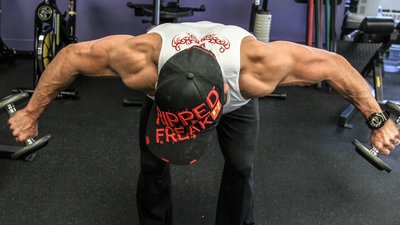The shoulders play a key role in nearly every upper body exercise. Because of their critical function, extreme range of motion, and potential to bulge under your shirt like two stolen cannonballs, strong shoulders are essential for maximum performance and a well-rounded, fit physique. This article will help you maximize your shoulder development with a science-based exercise attack.
Shoulder Structure And Function
Before you train, it's important to understand the muscles you're targeting. Your shoulders are composed of the larger deltoid muscles—anterior, medial, posterior—and smaller rotator cuff muscles that support the ball and socket joint. The rotator cuff is made up of four muscles—the teres minor, infraspinatus, supraspinatus, and subscapularis—which aid in all overhead and rotational movements at the shoulder.
The deltoid muscles are the prime mover of arm abduction—moving the arm away from the body—along the frontal plane. The front (anterior) muscles are involved in shoulder abduction when the shoulder is externally rotated—think lateral raises with your thumbs turned up. The anterior deltoid also works with the subscapularis, pectorals, and lats to internally rotate the humerus bone, effectively turning your thumbs in and towards the center of the body so your palms face back.[1]
The rear (posterior) fibers are strongly involved in transverse extension, as in cable back rows.[2] The lateral fibers perform basic shoulder abduction when the shoulder is internally rotated, like in lateral raises. They also perform shoulder transverse abduction, as in a reverse flye, when the shoulder is externally rotated.[3] An important function of the deltoid muscles is also to support the humeral head to prevent dislocation when carrying heavy loads, as in a heavy farmer's carry.[4]
Must-Do Movements
1. Standing Dumbbell Press
Sitting is overrated. While it might cause you to have a lower one-rep max, a standing dumbbell press better stimulates shoulder growth than a seated press. Though you'll be lifting less weight, the standing shoulder press requires more stability, so you'll be actively strengthening your core and adding balance to your physique while you smoke your shoulders.[5]
There's no doubt that the standing dumbbell press performed with a full range of motion is the best deltoid exercise you can do for maximum recruitment. A study from the University of Padova found that using the widest range of motion when performing the military shoulder press—elbows fully extended at 180 degrees—resulted in a significant increase in electromyogram (EMG) activation of the pectoralis major, anterior deltoid, medial deltoid, posterior deltoid, upper trapezius, middle trapezius, long head of triceps, and teres minor.[6]
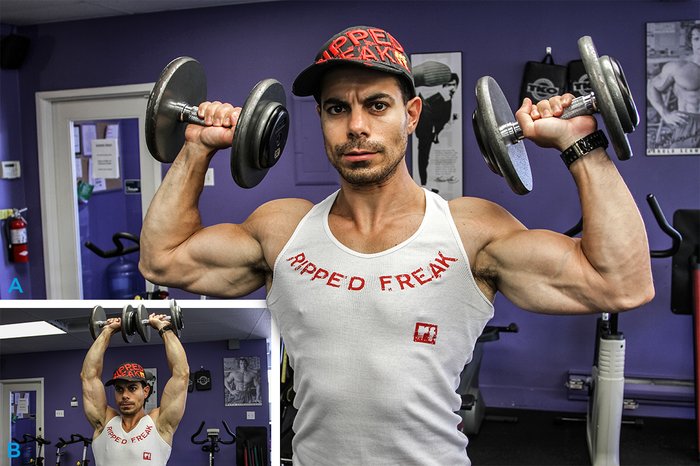
Standing Dumbbell Press
Execution
If you haven't been fully extending your elbows during your shoulder presses, you're in for a surprise. Check your ego at the door, drop the weight, use a full range of motion, and reap the rewards of working smarter and harder with the following steps:
- With your feet shoulder-width apart, take a dumbbell in each hand.
- Raise the dumbbells to eye level with your elbows bent to about 90 degrees.
- Brace your core and drive the dumbbells up and together, extending the elbows to 180 degrees.
- Pause, and slowly return the weight to the starting position.
2. Prone Reverse Fly
Skip the machines. A recent study showed that the EMG activity for the posterior deltoid and infraspinaturs was greatest when performing a reverse fly with a neutral hand position (palms facing each other) compared to a pronated grip (palms down). While you might be tempted to hop onto the seated reverse fly machine, you're better off using free weights and a bench to perform the prone reverse dumbbell fly. Not only do free weights allow you to get in the optimal hand position, the movement also better isolates the rear delts and recruits more stabilizers than the machines.[7]
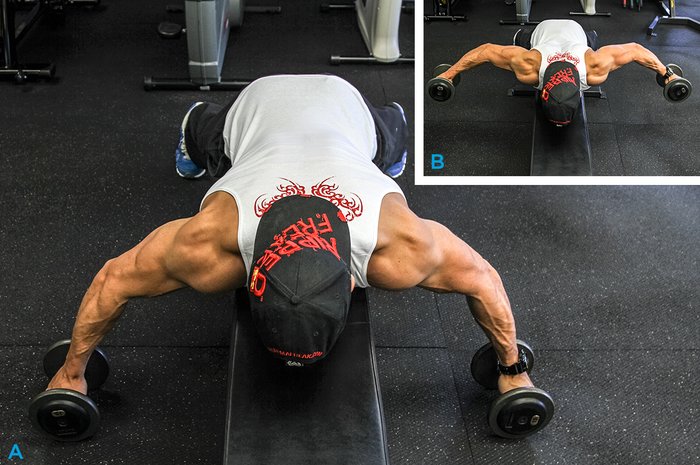
Prone reverse fly
Execution
- Lie face down on a flat bench with the balls of your feet firmly planted into the ground for support. You can roll up a towel and place it under your forehead for comfort.
- Grasp the dumbbells with your arms angled out and a slight bend in your elbows.
- Retract your shoulder blades as you bring the weight up, squeeze, and then lower the weight under control.
- Repeat. Maintain constant control and tension throughout each rep.
3. Bent-Over Reverse Fly 21s
This triset targets the rear delts while hitting the medial and front heads as well. It's a great variation to throw into the end of your routine. Remember to keep the weight light in order to maintain proper form and keep the mind-muscle connection you need to maximize every rep.
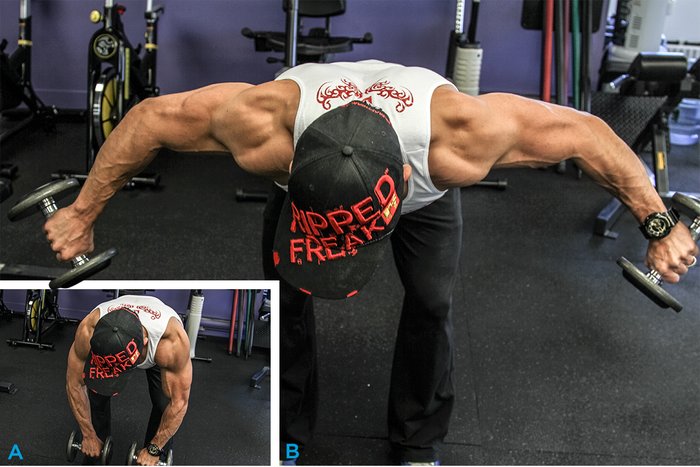
Bent-Over Reverse Fly 21s
Execution
- Start in a bent-over position with your core tight and knees slightly bent.
- Perform the first seven reps with a neutral grip (palms facing each other). Retract the scapula, squeeze, and slowly resist the negative.
- Perform the next seven reps with a prone grip (palms facing down). Lead with the pinkies out as you squeeze the rear delts during each rep.
- For the last seven reps, turn the palms back to a neutral grip and perform a forward raise. Keep the shoulders down as your raise the dumbbells and slowly lower them with control.
4. Lateral Raises With Kettlebells
Take your standard dumbbell lateral raises to a new level. Using kettlebells will add an extra challenge for your forearms and shoulder stabilizers since you really need to control each rep's weight, which isn't directly in your palms. It is important to focus on squeezing the deltoids instead of allowing momentum to take over the movement.
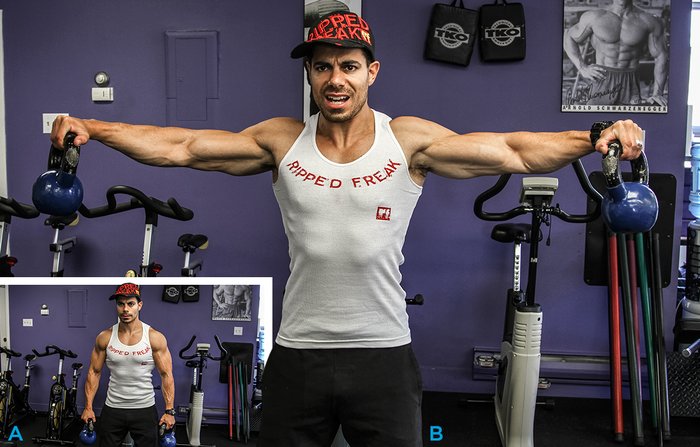
Lateral Raises With Kettlebells
Execution
- Grab a pair of kettlebells and hold them at your sides.
- With your elbows slightly bent and your wrists locked, lift each kettlebell up and out to the side until your arms are parallel to the ground. Turn your thumbs down at the peak contraction to better target your side delts.
- Pause for a second and slowly lower back to starting position.
Advanced variation: Perform this with the weight hanging directly underneath the handle and go heavier.
5. Neutral-Grip Sternum Chin-Up
If you've never performed this version of a chin-up, you're missing out. Give it a shot. Not only does it hit your lats and rear delts harder than a traditional chin-up, it also blasts your core.
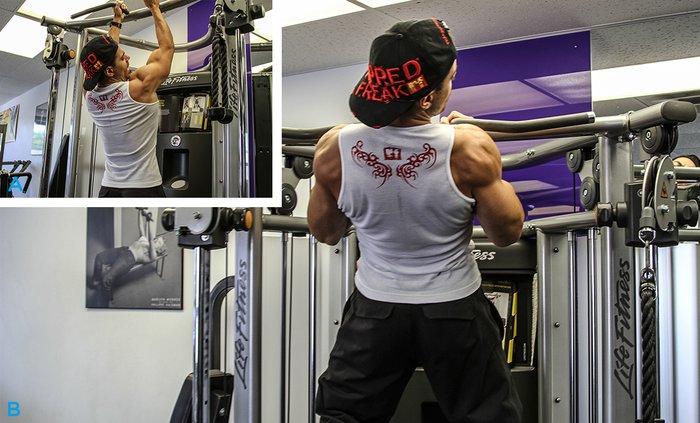
Neutral-Grip Sternum Chin-Up
Execution
- Start with a neutral grip on the chin-up bars. Pull your shoulder blades together and drive yourself up until your chest reaches the bar.
- Keep your chest and shoulders open as you pull yourself up. Focuson the rear delt squeeze at the peak contraction. At the top of the move, your body should be at a 45 degree angle from the ground.
- Brace your entire body as you slowly lower yourself back to the starting position with your torso upright.
References
- http://www.exrx.net/Muscles/DeltoidAnterior.html
- http://www.exrx.net/Muscles/DeltoidPosterior.html
- http://www.exrx.net/Muscles/DeltoidLateral.html
- Potau JM, et al. Quantitative Analysis of the Deltoid and Rotator Cuff Muscles in Humans and Great Apes. Int J Primatol 2009; 30:697-708.
- Saeterbakken AH and Fimland MS. Effects of body position and loading modality on muscle activity and strength in shoulder presses. J Strength Cond Res; 2013 Jul;27(7):1824-31.
- Paoli A, et al. Influence of different ranges of motion on selective recruitment of shoulder muscles in the sitting military press: an electromyographic study. J Strength Cond Res; 2010 Jun;24(6):1578-83.
- Schoenfeld B, et al. Effect of hand position on EMG activity of the posterior shoulder musculature during a horizontal abduction exercise. J Strength Cond Res; 2013 Jan 8. [Epub ahead of print]

